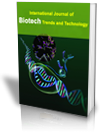Differentiation of Environmental Bacteria Using Hyperspectral Imaging Technology And Multivariate Analysis
Citation
MLA Style:Aline Rodrigues Gama, Venine Prado Saêta, Raylane Pereira Gomes, José Daniel Gonçalves Vieira, Monica Santigo Barbosa, Luiz Artur Mendes Bataus, Arlindo Rodrigues Galvão Filho, Clarimar José Coelho, Lilian Carla Carneiro"Differentiation of Environmental Bacteria Using Hyperspectral Imaging Technology And Multivariate Analysis" International Journal of Biotech Trends and Technology 10.3 (2020): 1-5.
APA Style:Aline Rodrigues Gama, Venine Prado Saêta, Raylane Pereira Gomes, José Daniel Gonçalves Vieira, Monica Santigo Barbosa, Luiz Artur Mendes Bataus, Arlindo Rodrigues Galvão Filho, Clarimar José Coelho, Lilian Carla Carneiro(2020). Differentiation of Environmental Bacteria Using Hyperspectral Imaging Technology And Multivariate Analysis. International Journal of Biotech Trends and Technology, 10(3), 1-5.
Abstract
Efficiency in the identification of bacterial isolates is of paramount importance in clinical microbiology for the correct diagnosis of infections and their subsequent treatment. It is also highly required in environmental microbiology to identify new isolates and the knowledge of the biodiversity of an environment. This raises the need for the development of identification methodologies, which make this practice accessible, safe, and at lower costs, with the emergence, in this sense, of the use of hyperspectral imaging technologies (HSI). In this study, we investigated the potential of HSI in differentiating different bacterial genera. For this, bacterial isolates obtained from water samples were previously sequenced and identified based on the 16S rRNA gene and then grown in Petri dishes containing culture medium. The HSI of each isolate was acquired using an short infrared wave imaging system (SWIR) at the SisuCHEMA workstation. Principal component analyzes showed a clear differentiation between genera and bacterial species. To transform these differentiation assays into an applicable identification methodology, it is necessary to build robust databases capable of covering the wide range of bacterial diversity. The primary results demonstrate that HSI is an objective tool and widely capable of promoting improvements in the identification of bacteria.
References
[1] Noiphung J, Laiwattanapaisal W. “Multifunctional Paper- Based Analytical Device for In Situ Cultivation and Screening of Escherichia coli Infections”. Sci Rep;9(1):1–10 (2019).
[2] Srinivasan R, Karaoz U, Volegova M, MacKichan J, Kato- Maeda M, Miller S, et al. “Use of 16S rRNA gene to identify a broad range of clinically relevant bacterial pathogens”. PLoS One; 10(2):e0117617 (2015)
[3] Özenci V, Rossolini GM. “Rapid microbial identification and antimicrobial susceptibility testing to drive better patient care: an evolving scenario”. J Antimicrob Chemother; 74:I2–5 (2019).
[4] Pandey A, Jain R, Sharma A, Dhakar K, Kaira GS, Rahi P, Dhyani A, Pandey N, Adhikari P, Shouche YS. 16S rRNA gene sequencing and MALDI-TOF mass spectrometrybased comparative assessment and bioprospection of psychrotolerant bacteria isolated from high altitudes under the mountain ecosystem. SN Appl Sci;1(3):1–12 (2019).
[5] Feng YZ, Yu W, Chen W, Peng KK, Jia GF. “Invasive weed optimization for optimizing one-agar-for-all classification of bacterial colonies based on hyperspectral imaging. Sensors Actuators,” B Chem; 269:264–70 (2018).
[6] Tillman GE, Wasilenko JL, Simmons M, Lauze TA, Minicozzi J, Oakley BB, Narang N, Fratamico P, Cray WC. “Isolation of Shiga Toxin-Producing Escherichia coli Serogroups “O26, O45, O103, O111, O121, and O145 from Ground Beef Using Modified Rainbow Agar and Post– Immunomagnetic Separation Acid Treatment. J Food Prot; 75(9):1548–54 (2012).
[7] Yoon SH, Ha SM, Kwon S, Lim J, Kim Y, Seo H, Chun J. “Introducing EzBioCloud: A taxonomically united database of 16S rRNA gene sequences and whole-genome assemblies.” Int J Syst Evol Microbiol; 67(5):1613–7 (2017).
[8] Gowen AA, Feng Y, Gaston E, Valdramidis V. “Recent applications of hyperspectral imaging in microbiology”. Talanta;137:43–54 (2015).
[9] Sandasi M, Vermaak I, Chen W, Viljoen AM. “Hyperspectral imaging and chemometric modeling of Echinacea - A novel approach in the quality control of herbal medicines”. Molecules;19(9):13104–21 (2014).
[10] Yoon SC, Lawrence KC, Park B. “Automatic Counting and Classification of Bacterial Colonies Using Hyperspectral Imaging”. Food Bioprocess Technol; 8(10):2047–65 (2015).
[11] Rosenblueth M, Martínez L, Silva J, Martínez-Romero E. Klebsiella variicola, A Novel Species with Clinical and Plant-Associated Isolates. Syst Appl Microbiol; 27(1):27–35 (2004).
[12] Rodríguez-Medina N, Barrios-Camacho H, Duran-Bedolla J, Garza-Ramos U. Klebsiella variicola: an emerging pathogen in humans. Emerg Microbes Infect; 8(1):973–88 (2019).
[13] Liu JR, Lin YD, Chang ST, Zeng YF, Wang SL. “Molecular Cloning and Characterization of an Insecticidal Toxin from Pseudomonas taiwanensis”. J Agric Food Chem; 8;58(23):12343–9 (2010).
[14] Chen WJ, Hsieh FC, Hsu FC, Tasy YF, Liu JR, Shih MC. “Characterization of an Insecticidal Toxin and Pathogenicity of Pseudomonas taiwanensis against Insects”. Schneider DS, editor. PLoS Pathog; 21;10(8):e1004288 (2014).
[15] Zhang CX, Yang SY, Xu MX, Sun J, Liu H, Liu JR. Serratia nematodiphila sp. nov., associated symbiotically with the entomopathogenic nematode Heterorhabditidoides chongmingensis (Rhabditida: Rhabditidae). Int J Syst Evol Microbiol; 1;59(7):1603–8 (2009).
[16] Lasch P, Stämmler M, Zhang M, Baranska M, Bosch A, Majzner K. “FT-IR Hyperspectral Imaging and Artificial Neural Network Analysis for Identification of Pathogenic Bacteria”. Anal Chem; 90(15):8896–904 (2018).
[17] Park B, Seo Y, Eady M, Yoon S-C, Hinton, Jr. A, Lawrence KC. “Classification of Salmonella Serotypes with Hyperspectral Microscope Imagery”. Ann Clin Pathol; 5(2):1108 (2017).
[18] Seo Y, Park B, Hinton A, Yoon SC, Lawrence KC. “Identification of Staphylococcus species with hyperspectral microscope imaging and classification algorithms”. J Food Meas Charact; 10(2):253–63 (2016).
[19] Foca G, Ferrari C, Ulrici A, Sciutto G, Prati S, Morandi S, Brasca M, Lavermicocca P, Lanteri S. Oliveri P. “The potential of spectral and hyperspectral imaging techniques for bacterial detection in food: A case study on lactic acid bacteria”. Talanta; 153:111–9 (2016).
[20] Dr. Badr Al ALI , Dr. Ahmed QARA ALI, Rami HAMMOD, "Chemical Compounds And the Vital Importance of Organic Extract of Bacillus Polymyxa Marine Bacteria" SSRG International Journal of Agriculture & Environmental Science 6.5 (2019): 1-3.
Keywords
Microbiology; SisuCHEMA; SWIR; biotechnology.


